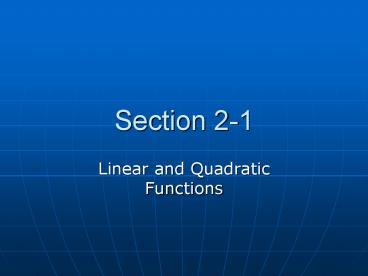Linear and Quadratic Functions - PowerPoint PPT Presentation
1 / 11
Title:
Linear and Quadratic Functions
Description:
... involve the use of the slope formula, slope-intercept form, and point-slope form ... the regression line has positive slope then there is a 'positive ... – PowerPoint PPT presentation
Number of Views:311
Avg rating:3.0/5.0
Title: Linear and Quadratic Functions
1
Section 2-1
- Linear and Quadratic Functions
2
Section 2-1
- polynomial functions
- linear functions
- rate of change
- linear correlation
- quadratic functions
- vertical motion problems
3
Polynomial Functions
- the only operations on the variable are mult.,
addition, and subtraction - examples of poly.s
4
Polynomial Functions
- functions which are not polynomials
- variable under a square root
- variable in an exponent
- variable in a denominator
- variable with a negative exponent
5
Linear Functions
- in the form
- m is the slope and b is the y-intercept
- linear functions have degree 1
- problems might involve the use of the slope
formula, slope-intercept form, and point-slope
form
6
Rate of Change
- the average rate of change between two values (x
a and x b) is given by the following
equation - for a linear function, the average rate of
change is constant (the slope) and the initial
value is the y-intercept
7
Linear Correlation
- when points of a scatter plot are clustered
around a line we say there is a linear
correlation between the quantities represented
by the data - if the regression line has positive slope then
there is a positive correlation and r gt 0 (same
for negative and r lt 0) - if r is near 1 then there is strong correlation
and near 0 is weak or no correlation
8
Quadratic Functions
- the graph of a quadratic function is called a
parabola - graphs can be sketched using the normal
transformations if the equation is written in
vertex form
9
Quadratic Functions
- if the equation is in standard form then finding
the vertex takes a little work - to convert from standard form to vertex form you
must complete the square
10
Vertical Motion
- a special quadratic equation is used to track
the height of an object (that is moving
vertically) versus time - g is the force due to gravity and which value
you use depends on the units
11
Vertical Motion
- there is a linear equation which can track the
vertical velocity of the object at a given time - you can use these functions to find out the
maximum height the object can reach, when it hits
the ground, or its velocity when it hits the
ground (or other things as well)































